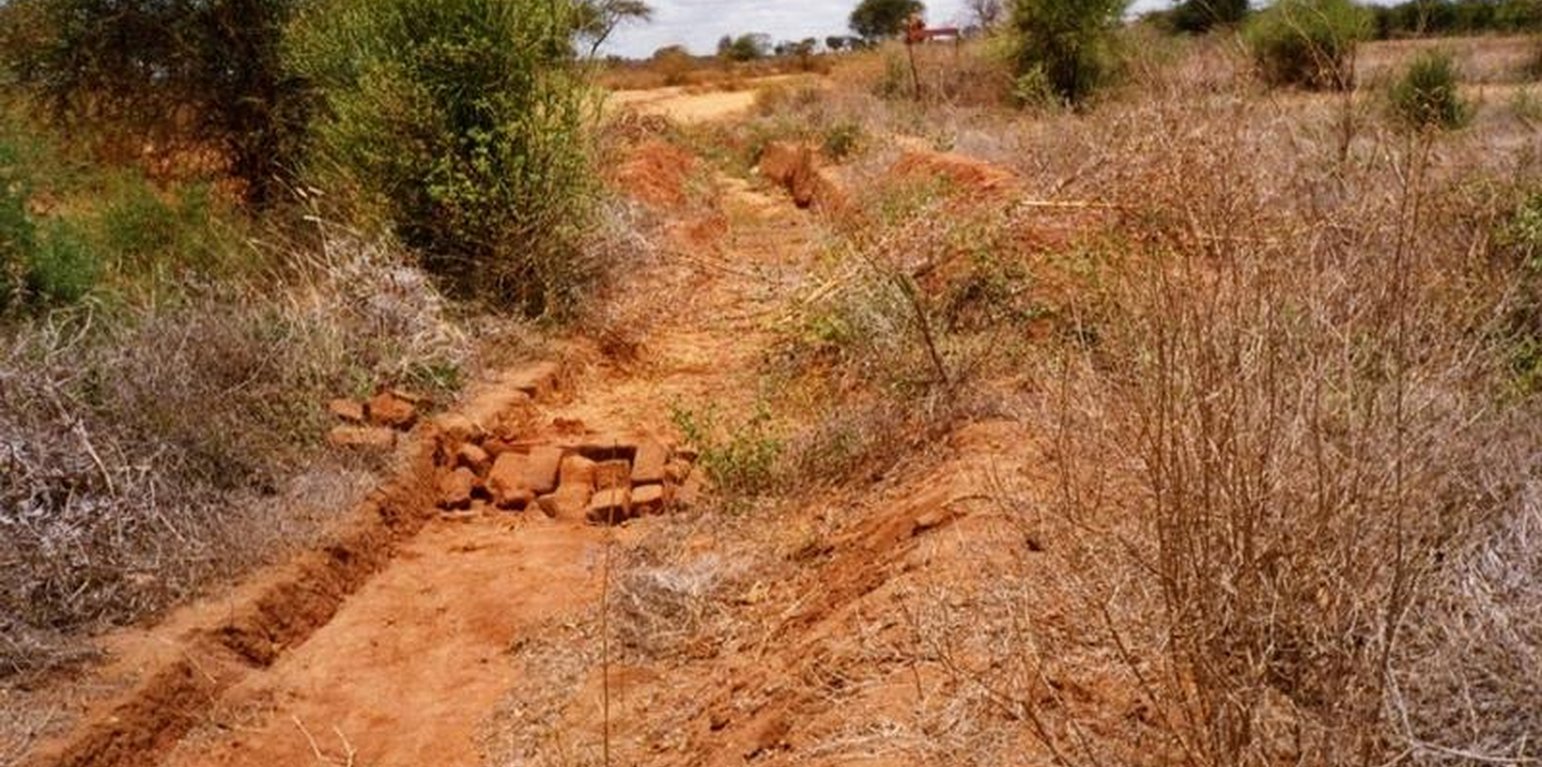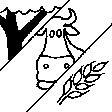Water harvest
(เคนยา)
Kunasa maji ya muua yanuyobubugika na kuyuelekeza shambani kwa uzakshaji-Alex R.Adual RSCU/SIDA1996
คำอธิบาย
Water harvest for agricultural production in Asals
Water harvest enhances extra moisture and reduces risk of crop failure. It can either be external or internal. The activities also reduce runoff/overland flow and soil loss.
Manure and fertilizer improve soil water holding capacity and soil properties.
Appropriate tillage for improvement of infiltration rate of the soil.
สถานที่
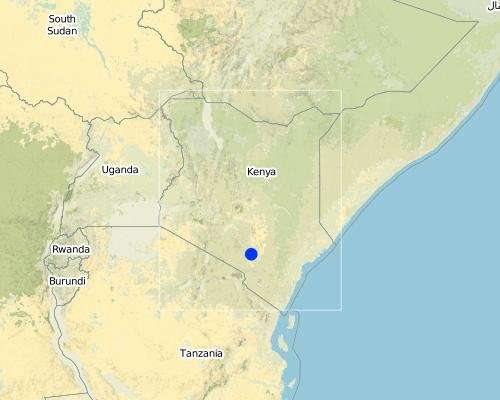
สถานที่: KiMuiki, Kitise, Mburo, Kwa Kauisi, Eastern, เคนยา
ตำนวนการวิเคราะห์เทคโนโลยี:
ตำแหน่งทางภูมิศาสตร์ของสถานที่ที่ถูกเลือ
การเผยแพร่ของเทคโนโลยี:
วันที่ในการดำเนินการ: น้อยกว่า 10 ปี (ไม่นานนี้)
ประเภทของการแนะนำ
-
ด้วยการริเริ่มของผู้ใช้ที่ดินเอง
-
เป็นส่วนหนึ่งของระบบแบบดั้งเดิมที่ทำก้นอยู่ (> 50 ปี)
-
ในช่วงการทดลองหรือการทำวิจัย
-
ทางโครงการหรือจากภายนอก
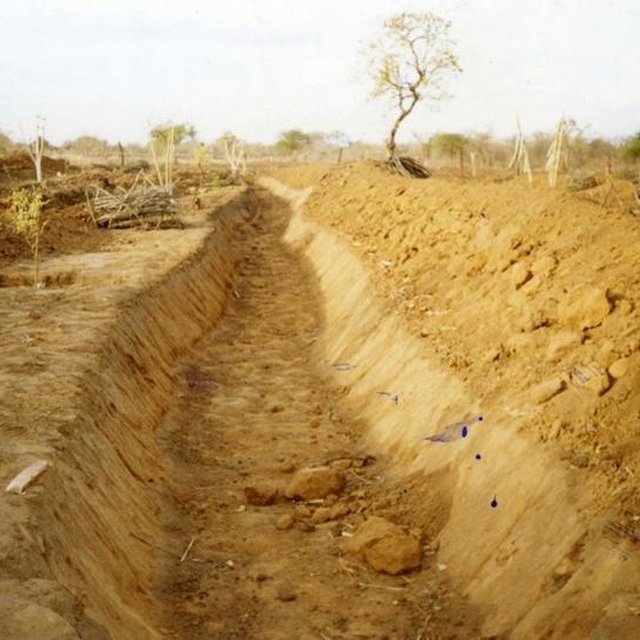
Retention/nfiltration ditch (Justus N.Mutinda, David K. Wam)
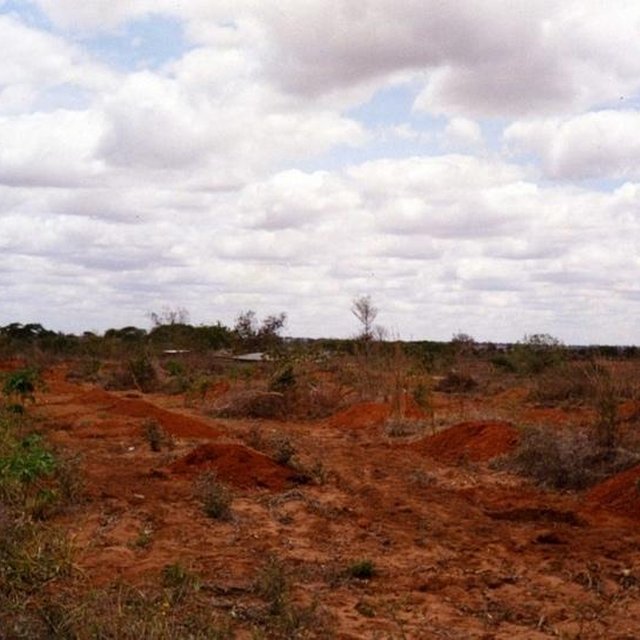
Agroforestry establishment (mangoes plot) (Justus N.Mutinda, David K.Wamb)
จุดประสงค์หลัก
-
ปรับปรุงการผลิตให้ดีขึ้น
-
ลด ป้องกัน ฟื้นฟู การเสื่อมโทรมของที่ดิน
-
อนุรักษ์ระบบนิเวศน์
-
ป้องกันพื้นที่ลุ่มน้ำ/บริเวณท้ายน้ำ โดยร่วมกับเทคโนโลยีอื่นๆ
-
รักษาสภาพหรือปรับปรุงความหลากหลายทางชีวภาพ
-
ลดความเสี่ยงของภัยพิบัติ
-
ปรับตัวเข้ากับการเปลี่ยนแปลงภูมิอากาศของโลก สภาพภูมิอากาศที่รุนแรงและผลกระทบ
-
ชะลอการเปลี่ยนแปลงภูมิอากาศของโลกและผลกระทบ
-
สร้างผลกระทบทางด้านเศรษฐกิจที่เป็นประโยชน์
-
สร้างผลกระทบทางด้านสังคมที่เป็นประโยชน์
การใช้ที่ดิน
-
พื้นที่ปลูกพืช - การปลูกพืชล้มลุกอายุปีเดียว
พืชหลัก (พืชเศรษฐกิจและพืชอาหาร): Major food crop: Maize
Other: C.peas
-
การใช้ที่ดินแบบผสมผสาน (รวมถึงวนเกษตร) - การปลูกพืชร่วมกับปศุสัตว์และการทำป่าไม้ (Agro-silvopastoralism)
ผลิตภัณฑ์หลักหรือบริการ: Major cash crop CT: fruits
Selective felling of (semi-) natural forests for fuelwood purpose
Clear felling of (semi-)natural forests for agricultural production
Forest also for fruits and nuts
การใช้น้ำ
-
จากน้ำฝน
-
น้ำฝนร่วมกับการชลประทาน
-
การชลประทานแบบเต็มรูปแบบ
จำนวนของฤดูปลูกต่อปี:
2
การใช้ที่ดินก่อนการดำเนินการโดยเทคโนโลยี:
n.a.
ความหนาแน่นของปศุสัตว์:
n.a.
ความมุ่งหมายที่เกี่ยวข้องกับการเสื่อมโทรมของที่ดิน
-
ป้องกันความเสื่อมโทรมของที่ดิน
-
ลดความเสื่อมโทรมของดิน
-
ฟื้นฟูบำบัดที่ดินที่เสื่อมโทรมลงอย่างมาก
-
ปรับตัวกับสภาพความเสื่อมโทรมของที่ดิน
-
ไม่สามารถใช้ได้
ที่อยู่ของการเสื่อมโทรม
-
การกัดกร่อนของดินโดยน้ำ - Wt (Loss of topsoil): การสูญเสียดินชั้นบนหรือการกัดกร่อนที่ผิวดิน
-
การเสื่อมโทรมของดินทางด้านเคมี - Cn (Fertility decline): ความอุดมสมบูรณ์และปริมาณอินทรียวัตถุในดินถูกทำให้ลดลงไป (ไม่ได้เกิดจากสาเหตุการกัดกร่อน)
-
การเสื่อมโทรมของดินทางด้านกายภาพ - Pk (Slaking and crusting): การอุดตันของช่องว่างในดินหรือรูพรุน, Pi (Soil sealing)
มาตรการ SLM
-
มาตรการอนุรักษ์ด้วยวิธีพืช - V2: หญ้าและไม้ยืนต้น
-
มาตรการอนุรักษ์ด้วยโครงสร้าง - S3: Graded ditches, channels, waterways
แบบแปลนทางเทคนิค
ข้อมูลจำเพาะด้านเทคนิค
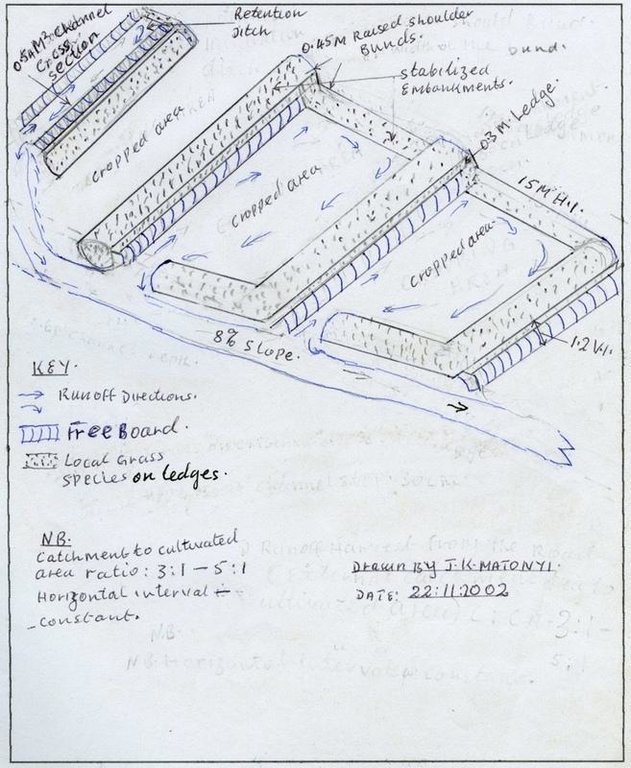
ผู้เขียน James K. Matonyi
technical drawing catchment to cultural area ratio: 3:1 - 5:1 Horizontal interval constant
Makueni district
Date: 22.11.2002
Technical knowledge required for field staff / advisors: moderate
Technical knowledge required for land users: high
Main technical functions: water harvesting / increase water supply
Secondary technical functions: increase / maintain water stored in soil, increase in soil fertility
Relay cropping
Material/ species: improved mango trees
Quantity/ density: 124
Remarks: 9 m^2
Manure / compost / residues
Material/ species: FYM/compost
Quantity/ density: 12.5 t/ha
Breaking compacted topsoil
Remarks: appropriate tillage
Aligned: -contour
Vegetative material: G : grass
Vertical interval between rows / strips / blocks (m): 1.2
Spacing between rows / strips / blocks (m): 0.6x0.3
Vertical interval within rows / strips / blocks (m): 15
Width within rows / strips / blocks (m): 1.5
Scattered / dispersed
Vegetative material: T : trees / shrubs
Number of plants per (ha): 40
In blocks
Vegetative material: T : trees / shrubs
Number of plants per (ha): 124
Vertical interval between rows / strips / blocks (m): 9
Spacing between rows / strips / blocks (m): 9x9
Vertical interval within rows / strips / blocks (m): 9
Trees/ shrubs species: Cacia scamea, Accacia albida
Fruit trees / shrubs species: mango, citrus, pawpaw
Grass species: ceuchrus cuharis, erayroster superba
Slope (which determines the spacing indicated above): 8.00%
If the original slope has changed as a result of the Technology, the slope today is (see figure below): 0.00%
Gradient along the rows / strips: 0.20%
Retention/infiltration ditch/pit, sediment/sand trap
Vertical interval between structures (m): 1.2
Depth of ditches/pits/dams (m): 0.6
Width of ditches/pits/dams (m): 1.2
Length of ditches/pits/dams (m): 100
Height of bunds/banks/others (m): 0.45
Width of bunds/banks/others (m): 1.5
Terrace: bench level
Vertical interval between structures (m): 1.2
Spacing between structures (m): 15
Depth of ditches/pits/dams (m): 0.6
Length of ditches/pits/dams (m): 100
Height of bunds/banks/others (m): 0.45
Construction material (earth): earth moving for SWC embankment construction
Slope (which determines the spacing indicated above): 8%
Lateral gradient along the structure: 0.2%
Vegetation is used for stabilisation of structures.
Change of land use type: stock holding capacity of land
การจัดตั้งและการบำรุงรักษา: กิจกรรม ปัจจัยและค่าใช้จ่าย
การคำนวนต้นทุนและค่าใช้จ่าย
- ค่าใช้จ่ายถูกคำนวน
- สกุลเงินที่ใช้คำนวณค่าใช้จ่าย ดอลลาร์สหรัฐ
- อัตราแลกเปลี่ยน (ไปเป็นดอลลาร์สหรัฐ) คือ 1 ดอลลาร์สหรัฐ = ไม่มีคำตอบ
- ค่าจ้างเฉลี่ยในการจ้างแรงงานต่อวันคือ 1.92
ปัจจัยที่สำคัญที่สุดที่มีผลต่อค่าใช้จ่าย
Factors affecting the costs include hard ground at SWC peak period, labour, slope, catchment area, channel size and source of income
กิจกรรมเพื่อการจัดตั้ง
-
grass planting on embankments (ช่วงระยะเวลา/ความถี่: after onset of rain)
-
fruits seedling transplanting (ช่วงระยะเวลา/ความถี่: october rain)
-
dispersed tree seedlings transplanting (ช่วงระยะเวลา/ความถี่: october rain)
-
retention/infiltration ditches (ช่วงระยะเวลา/ความถี่: after crop harvest)
-
Bench terraces (ช่วงระยะเวลา/ความถี่: after crop harvest)
-
external water harvest channels (ช่วงระยะเวลา/ความถี่: before raining season)
-
structure stabilization (ช่วงระยะเวลา/ความถี่: onset of rain)
-
manure/fertilizer application (ช่วงระยะเวลา/ความถี่: after crop harvest)
-
Bush clearing (ช่วงระยะเวลา/ความถี่: after grazing)
-
reseeding/grass planting in bare parches (ช่วงระยะเวลา/ความถี่: dry season)
-
fodder establishment (ช่วงระยะเวลา/ความถี่: rainy season)
-
removal of unwanted shrubs (ช่วงระยะเวลา/ความถี่: following rotational sequence)
ปัจจัยและค่าใช้จ่ายของการจัดตั้ง
| ปัจจัยนำเข้า |
หน่วย |
ปริมาณ |
ค่าใช้จ่ายต่อหน่วย (ดอลลาร์สหรัฐ) |
ค่าใช้จ่ายทั้งหมดต่อปัจจัยนำเข้า (ดอลลาร์สหรัฐ) |
%ของค่าใช้จ่ายที่ก่อให้เกิดขึ้นโดยผู้ใช้ที่ดิน |
|
แรงงาน
|
| Labour |
ha |
1.0 |
296.0 |
296.0 |
100.0 |
|
อุปกรณ์
|
| Machine use |
ha |
1.0 |
32.5 |
32.5 |
100.0 |
| Animal traction |
ha |
1.0 |
72.3 |
72.3 |
100.0 |
| Tools |
ha |
1.0 |
385.0 |
385.0 |
100.0 |
|
วัสดุด้านพืช
|
| Seeds |
ha |
1.0 |
76.3 |
76.3 |
100.0 |
| Seedligs |
ha |
1.0 |
79.5 |
79.5 |
100.0 |
|
ปุ๋ยและสารฆ่า/ยับยั้งการเจริญเติบโตของสิ่งมีชีวิต (ไบโอไซด์)
|
| Fertilizer |
ha |
1.0 |
58.0 |
58.0 |
100.0 |
| Biocides |
ha |
1.0 |
47.4 |
47.4 |
100.0 |
| Compost/manure |
ha |
1.0 |
78.0 |
78.0 |
100.0 |
|
วัสดุสำหรับก่อสร้าง
|
| Stone |
ha |
1.0 |
244.0 |
244.0 |
100.0 |
| ค่าใช้จ่ายทั้งหมดของการจัดตั้งเทคโนโลยี |
1'369.0 |
|
กิจกรรมสำหรับการบำรุงรักษา
-
tillaging (ช่วงระยะเวลา/ความถี่: before rain / annually)
-
tillaging (ช่วงระยะเวลา/ความถี่: on set / seasonally)
-
manure application (ช่วงระยะเวลา/ความถี่: dry season / annually)
-
grass cutting and gapping (ช่วงระยะเวลา/ความถี่: onset of rain /twice per season)
-
prunning and trimming (ช่วงระยะเวลา/ความถี่: after every harvest /annual)
-
pollading and copsing (ช่วงระยะเวลา/ความถี่: when intended /after several years)
-
retention/infiltration (ช่วงระยะเวลา/ความถี่: before onset of rain/seasonally)
-
ditch cleaning (ช่วงระยะเวลา/ความถี่: before onset of rain/anually)
-
Bench terraces repairing (ช่วงระยะเวลา/ความถี่: before onset of rain/when necessary)
-
Water channel cleaning/repairing (ช่วงระยะเวลา/ความถี่: dry period/seasonally)
-
grass cutting for stall feedinf (ช่วงระยะเวลา/ความถี่: rainy season / at maturity stage)
-
gapping (ช่วงระยะเวลา/ความถี่: rainy season / seasonally)
ปัจจัยและค่าใช้จ่ายของการบำรุงรักษา
| ปัจจัยนำเข้า |
หน่วย |
ปริมาณ |
ค่าใช้จ่ายต่อหน่วย (ดอลลาร์สหรัฐ) |
ค่าใช้จ่ายทั้งหมดต่อปัจจัยนำเข้า (ดอลลาร์สหรัฐ) |
%ของค่าใช้จ่ายที่ก่อให้เกิดขึ้นโดยผู้ใช้ที่ดิน |
|
แรงงาน
|
| Labour |
ha |
1.0 |
98.0 |
98.0 |
100.0 |
|
อุปกรณ์
|
| Animal traction |
ha |
1.0 |
72.3 |
72.3 |
100.0 |
|
วัสดุด้านพืช
|
| Seeds |
ha |
1.0 |
67.3 |
67.3 |
100.0 |
| Seedlings |
ha |
1.0 |
55.7 |
55.7 |
100.0 |
|
ปุ๋ยและสารฆ่า/ยับยั้งการเจริญเติบโตของสิ่งมีชีวิต (ไบโอไซด์)
|
| Fertilizer |
ha |
1.0 |
44.2 |
44.2 |
100.0 |
| Biocides |
ha |
1.0 |
21.5 |
21.5 |
100.0 |
|
วัสดุสำหรับก่อสร้าง
|
| Earth |
ha |
1.0 |
244.0 |
244.0 |
100.0 |
| ค่าใช้จ่ายทั้งหมดของการบำรุงรักษาสภาพเทคโนโลยี |
603.0 |
|
สิ่งแวดล้อมทางธรรมชาติ
ปริมาณน้ำฝนเฉลี่ยรายปี
-
< 250 ม.ม.
-
251-500 ม.ม.
-
501-750 ม.ม.
-
751-1,000 ม.ม.
-
1,001-1,500 ม.ม.
-
1,501-2,000 ม.ม.
-
2,001-3,000 ม.ม.
-
3,001-4,000 ม.ม.
-
> 4,000 ม.ม.
เขตภูมิอากาศเกษตร
-
ชื้น
-
กึ่งชุ่มชื้น
-
กึ่งแห้งแล้ง
-
แห้งแล้ง
ข้อมูลจำเพาะเรื่องภูมิอากาศ
ปริมาณเฉลี่ยฝนรายปีในหน่วยมม. 350.0
semi-arid: LGP-70-180
arid: LGP-60-120
ความชัน
-
ราบเรียบ (0-2%)
-
ลาดที่ไม่ชัน (3-5%)
-
ปานกลาง (6-10%)
-
เป็นลูกคลื่น (11-15%)
-
เป็นเนิน (16-30%)
-
ชัน (31-60%)
-
ชันมาก (>60%)
ภูมิลักษณ์
-
ที่ราบสูง/ที่ราบ
-
สันเขา
-
ไหล่เขา
-
ไหล่เนินเขา
-
ตีนเนิน
-
หุบเขา
ความสูง
-
0-100 เมตร
-
101-500 เมตร
-
501-1,000 เมตร
-
1,001-1,500 เมตร
-
1,501-2,000 เมตร
-
2,001-2,500 เมตร
-
2,501-3,000 เมตร
-
3,001-4,000 เมตร
-
> 4,000 เมตร
เทคโนโลยีถูกประยุกต์ใช้ใน
-
บริเวณสันเขา (convex situations)
-
บริเวณแอ่งบนที่ราบ (concave situations)
-
ไม่เกี่ยวข้อง
ความลึกของดิน
-
ตื้นมาก (0-20 ซ.ม.)
-
ตื้น (21-50 ซ.ม.)
-
ลึกปานกลาง (51-80 ซ.ม.)
-
ลึก (81-120 ซ.ม.)
-
ลึกมาก (>120 ซ.ม.)
เนื้อดิน (ดินชั้นบน)
-
หยาบ/เบา (ดินทราย)
-
ปานกลาง (ดินร่วน ทรายแป้ง)
-
ละเอียด/หนัก (ดินเหนียว)
เนื้อดิน (> 20 ซม. ต่ำกว่าพื้นผิว)
-
หยาบ/เบา (ดินทราย)
-
ปานกลาง (ดินร่วน ทรายแป้ง)
-
ละเอียด/หนัก (ดินเหนียว)
สารอินทรียวัตถุในดิน
-
สูง (>3%)
-
ปานกลาง (1-3%)
-
ต่ำ (<1%)
น้ำบาดาล
-
ที่ผิวดิน
-
<5 เมตร
-
5-50 เมตร
-
> 50 เมตร
ระดับน้ำบาดาลที่ผิวดิน
-
เกินพอ
-
ดี
-
ปานกลาง
-
ไม่ดีหรือไม่มีเลย
คุณภาพน้ำ (ยังไม่ได้รับการบำบัด)
-
เป็นน้ำเพื่อการดื่มที่ดี
-
เป็นน้ำเพื่อการดื่มที่ไม่ดี (จำเป็นต้องได้รับการบำบัด)
-
เป็นน้ำใช้เพื่อการเกษตรเท่านั้น (การชลประทาน)
-
ใช้ประโยชน์ไม่ได้
ความเค็มของน้ำเป็นปัญหาหรือไม่?
การเกิดน้ำท่วม
ความหลากหลายทางชนิดพันธุ์
ความหลากหลายของแหล่งที่อยู่
ลักษณะเฉพาะของผู้ใช้ที่ดินที่ประยุกต์ใช้เทคโนโลยี
เป้าหมายทางการตลาด
-
เพื่อการยังชีพ (หาเลี้ยงตนเอง)
-
ผสม (การเลี้ยงชีพ/ทำการค้า)
-
ทำการค้า/การตลาด
รายได้จากภายนอกฟาร์ม
-
< 10% ของรายได้ทั้งหมด
-
10-50% ของรายได้ทั้งหมด
-
> 50% ของรายได้ทั้งหมด
ระดับของความมั่งคั่งโดยเปรียบเทียบ
-
ยากจนมาก
-
จน
-
พอมีพอกิน
-
รวย
-
รวยมาก
ระดับของการใช้เครื่องจักรกล
-
งานที่ใช้แรงกาย
-
การใช้กำลังจากสัตว์
-
การใช้เครื่องจักรหรือเครื่องยนต์
อยู่กับที่หรือเร่ร่อน
-
อยู่กับที่
-
กึ่งเร่ร่อน
-
เร่ร่อน
เป็นรายบุคคลหรือกลุ่ม
-
เป็นรายบุคคล/ครัวเรือน
-
กลุ่ม/ชุมชน
-
สหกรณ์
-
ลูกจ้าง (บริษัท รัฐบาล)
อายุ
-
เด็ก
-
ผู้เยาว์
-
วัยกลางคน
-
ผู้สูงอายุ
พื้นที่ที่ใช้ต่อครัวเรือน
-
< 0.5 เฮกตาร์
-
0.5-1 เฮกตาร์
-
1-2 เฮกตาร์
-
2-5 เฮกตาร์
-
5-15 เฮกตาร์
-
15-50 เฮกตาร์
-
50-100 เฮกตาร์
-
100-500 เฮกตาร์
-
500-1,000 เฮกตาร์
-
1,000-10,000 เฮกตาร์
-
>10,000 เฮกตาร์
ขนาด
-
ขนาดเล็ก
-
ขนาดกลาง
-
ขนาดใหญ่
กรรมสิทธิ์ในที่ดิน
-
รัฐ
-
บริษัท
-
เป็นแบบชุมชนหรือหมู่บ้าน
-
กลุ่ม
-
รายบุคคล ไม่ได้รับสิทธิครอบครอง
-
รายบุคคล ได้รับสิทธิครอบครอง
สิทธิในการใช้ที่ดิน
-
เข้าถึงได้แบบเปิด (ไม่ได้จัดระเบียบ)
-
เกี่ยวกับชุมชน (ถูกจัดระเบียบ)
-
เช่า
-
รายบุคคล
สิทธิในการใช้น้ำ
-
เข้าถึงได้แบบเปิด (ไม่ได้จัดระเบียบ)
-
เกี่ยวกับชุมชน (ถูกจัดระเบียบ)
-
เช่า
-
รายบุคคล
เข้าถึงการบริการและโครงสร้างพื้นฐาน
ผลกระทบ
ผลกระทบทางด้านเศรษฐกิจและสังคม
พื้นที่สำหรับการผลิต (ที่ดินใหม่ที่อยู่ในระหว่างเพาะปลูกหรือใช้งาน)
given area reduced by 14%
ภาระงาน
requires high labour costs
ผลกระทบด้านสังคมและวัฒนธรรม
SLM หรือความรู้เรื่องความเสื่อมโทรมของที่ดิน
ผลกระทบด้านนิเวศวิทยา
น้ำไหลบ่าที่ผิวดิน
จำนวนก่อน SLM: 32
หลังจาก SLM: 14
การสูญเสียดิน
จำนวนก่อน SLM: 20
หลังจาก SLM: 10
WH combination
ผลกระทบนอกพื้นที่ดำเนินการ
การไหลของน้ำคงที่และสม่ำเสมอในช่วงฤดูแล้ง(รวมถึงการไหลน้อย)
irrigation potential reduced
น้ำท่วมพื้นที่ท้ายน้ำ (ที่ไม่เป็นที่ต้องการ)
การทับถมของดินตะกอนพื้นที่ท้ายน้ำ
silt retained on cropland
รายได้และค่าใช้จ่าย
ผลประโยชน์ที่ได้รับเปรียบเทียบกับค่าใช้จ่าย
ผลตอบแทนระยะยาว
ด้านลบอย่างมาก
ด้านบวกอย่างมาก
ผลประโยชน์ที่ได้รับเปรียบเทียบกับค่าใช้จ่ายในการบำรุงรักษา
ผลตอบแทนระยะสั้น
ด้านลบอย่างมาก
ด้านบวกอย่างมาก
การเปลี่ยนแปลงของสภาพภูมิอากาศ
-
การน้อมเอาความรู้และการปรับใช้
เปอร์เซ็นต์ของผู้ใช้ที่ดินในพื้นที่ที่นำเทคโนโลยีไปใช้
-
ครั้งเดียวหรือเป็นการทดลอง
-
1-10%
-
10-50%
-
มากกว่า 50%
จากทั้งหมดที่ได้รับเทคโนโลยีเข้ามามีจำนวนเท่าใดที่ทำแบบทันที โดยไม่ได้รับการจูงใจด้านวัสดุหรือการเงินใดๆ?
-
0-10%
-
10-50%
-
50-90%
-
90-100%
จำนวนหลังคาเรือนหรือขนาดพื้นที่รวมทั้งหมด
630 household covered an area of 9%
เทคโนโลยีได้รับการปรับเปลี่ยนเร็วๆ นี้เพื่อให้ปรับตัวเข้ากับสภาพที่กำลังเปลี่ยนแปลงหรือไม่?
สภาพที่กำลังเปลี่ยนแปลงอันไหน?
-
การเปลี่ยนแปลงแบบค่อยเป็นค่อยไปและสภาพรุนแรงของภูมิอากาศ
-
การเปลี่ยนแปลงของตลาด
-
การมีแรงงานไว้ให้ใช้ (เนื่องจากการอพยพย้ายถิ่นฐาน)
บทสรุปหรือบทเรียนที่ได้รับ
จุดแข็ง: มุมมองของผู้ใช้ที่ดิน
-
induces the technique of implementation
How can they be sustained / enhanced? land users be aquidance with the technology and its importance.
-
land users acquires more grass for stall feeding.
How can they be sustained / enhanced? introduction of intensive grazing system.
-
reduces floods of heavy storms downsteram.
How can they be sustained / enhanced? Proper tillage to curb soil crusting and hardban.
จุดแข็ง: ทัศนคติของผู้รวบรวมหรือวิทยากรคนอื่นๆ
-
water harvest increases farm production and reduces risks of crop failure.
How can they be sustained / enhanced? To stabilize SWC structure embankments, desilt channels and retention ditches.
-
Improvement in infiltration rate and moisture holding capacity.
How can they be sustained / enhanced? Use of manure, organic matter, inorganic fertlizer and appropriate tillage.
-
Reduces soil, fertility, runoff and overland flow losses
How can they be sustained / enhanced? Maximum adaptability of the SWC technology to ustain high production level.
-
Enhanced vegetative cover for moisture retention.
How can they be sustained / enhanced? Intercropping, mulching and repairing where needed.
-
Reduces erosion by wind and other land degradation.
How can they be sustained / enhanced? Appropriate stocking rate andd replanting trees and grass.
จุดด้อย/ข้อเสีย/ความเสี่ยง: มุมมองของผู้ใช้ที่ดินแก้ไขปัญหาได้อย่างไร
-
consumes a lot of time to implement the technology
the land user awareness of the importance of the activity.
-
Technology area resists a direct grazing
to mitiate stall feeding
-
the technology design is beyond the farmers knowledge.
continuous interaction with SWC specialists.
จุดด้อย/ข้อเสีย/ความเสี่ยง: ทัศนคติของผู้รวบรวมหรือวิทยากรคนอื่นๆแก้ไขปัญหาได้อย่างไร
-
Land area reduced by SWC structures constructed.
Use of certified seeds, manure and fertilizer.
-
soil fertility is interfered with.
more manure and organic matter use.
-
High labour cost requirement to implement the technology.
Introduced source of smooth loan and policy for ASALS.
-
Risk of water logging where soil drainage is unaimable.
acquired knowledge of different soil types and applicable technology and system.
-
cost-benefit return can last long to be realized.
to maintain record for both, implementing cost and income from the given area (SWC area)
การอ้างอิง
วันที่จัดทำเอกสาร: 6 มิถุนายน 2011
การอัพเดทล่าสุด: 27 มีนาคม 2017
วิทยากร
-
Peter Maithya Mutisya - ผู้เชี่ยวชาญ SLM
-
Michael Ndengele - ผู้เชี่ยวชาญ SLM
-
Lucas Makau Nguluu - ผู้เชี่ยวชาญ SLM
-
Kithinji Mutunga (kithinji.mutunga@fao.org) - ผู้เชี่ยวชาญ SLM
-
Francis Mbote (pc+changeme2@nalep.co.ke) - ผู้เชี่ยวชาญ SLM
-
Alex R. Adunal - ผู้เชี่ยวชาญ SLM
คำอธิบายฉบับเต็มในฐานข้อมูล WOCAT
การจัดทำเอกสารถูกทำโดย
องค์กร
- Ministry of Agriculture and Livestock Development of Kenya (MoA) - เคนยา
โครงการ
การอ้งอิงหลัก
-
SWC manual for Kenya by D:B: Thomas. 1997.: Mard Kenya, free
-
SWC technology Dev. in ASAL by Kithinji Mutunga: SWC branch, free
-
SC in Kenya, Carl G.Wenner. 1984.: Aici, free
-
ony superb DXE-180 video: Mard Kenya, free
-
The sun will still rise: Mard Kenya, free
-
Run off a friend or a foe: Mard Kenya, free
